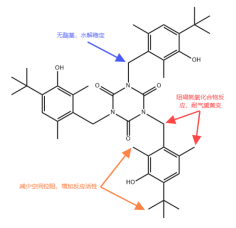Address:Room 906, building 6, SIIC Center, No.195 Hong Kong East Road, Laoshan District, Qingdao city, Shandong Province, China
E-mail:info@deltachem.net
Gas exposure yellowing refers to the yellowing phenomenon that occurs in materials due to gas exposure in a specific environment. Phenolic antioxidants such as BHT undergo a chemical reaction when in contact with nitrogen oxides (NOx) to form 2, 6-di-tert-butyl-p-nitrophenol (DTNP). This compound is colorless in an acidic state, but it sublimates and transfers very easily at room temperature. When it encounters alkaline substances, it immediately turns yellow, thus causing the yellowing phenomenon.

Why do phenolic antioxidants tend to cause yellowing due to fumigation? The traditional hindered phenolic antioxidant has two tert-butyl molecules at the adjacent position of the hydroxyl group, which has a large steric hindrance and low reactivity, and is prone to discoloration of plastic products. It is generally believed that the key to hindering the antioxidant effect of phenols lies in the reactive hydroxyl groups they contain. The reactivity of hydroxyl groups with free radicals is affected by the spatial hindrance of their adjacent R groups. The larger the R group is, the greater the hindrance and the smaller the reactivity. The steric hindrance of the large tert-butyl group has a protective effect on the phenolic hydroxyl group, which can prevent the phenolic hydroxyl group from being oxidized and consumed, and also play a complexing role in reducing charge transfer.
However, the excellent antioxidant effect and low cost of phenolic antioxidants make them highly cost-effective in polymer modification. But does that mean all phenolic antioxidants are prone to yellowing due to fumigation?
Of course not. Research has found that asymmetric hindered phenolic antioxidants have a semi-hindered phenolic structure with one methyl group and one tert-butyl group at the phenolic hydroxyl group site, which is sufficient to provide protection for themselves. At the same time, due to the weakening of the steric hindrance of the hindered phenolic hydroxyl group to a certain extent, the antioxidant reaction rate is accelerated. They not only have the general functions of hindered phenolic antioxidants, Moreover, the synergistic stabilizing effect and anti-staining effect with auxiliary antioxidants are more prominent than those of traditional symmetrical hindered phenols, perfectly solving the problem of yellowing caused by phenolic antioxidants through fumigation.
OMNISTAB has a series of asymmetric phenolic antioxidants. This article focuses on introducing OMNISTAB AN1790, an asymmetric phenolic antioxidant with high-temperature resistance. Its advantages are as follows:
>Highly efficient antioxidant performance;
>Low volatility, high-temperature resistant TGA(10%)354℃;
>Resistant to gas fading and yellowing caused by gas exposure;
>Excellent resistance to hydrolysis.

The structural formula of OMNISTAB AN1790
OMNISTAB AN1790 has good compatibility with most polymers and is widely used in polyolefins, elastic fibers, polyamides, styrene, polyurethanes, polyacetals, polyesters and other polymers. In addition, AN1790 has been approved for use in food contact materials and is an antioxidant that simultaneously possesses excellent anti-aging properties and safety.
For more information about the OMNISTAB AN1790, please feel free to consult our business personnel.